Balbharti Maharashtra State Board Class 12 Political Science Important Questions Chapter 6 India and the World Important Questions and Answers.
Maharashtra State Board 12th Political Science Important Questions Chapter 6 India and the World
Complete the following statements by selecting the appropriate option.
Question 1.
The core of nonalignment was
(a) Independent understanding of world affairs
(b) Participation in cold war
(c) Democratic socialism as policy
(d) Policy of regionalism
Answer:
(a) Independent understanding of world affairs
Question 2.
Farakka Agreement about sharing of river waters is between India and
(a) Bangladesh
(b) Pakistan
(c) China
(d) Nepal
Answer:
(a) Bangladesh
![]()
Question 3.
The vision for India Ocean Rim Association (IORA) originated in 1995 during the visit of to India.
(a) Nelson Mandela
(b) Yasser Arafat
(c) Pervez- Musharraf
(d) President Jayewardene
Answer:
(a) Nelson Mandela
Question 4.
The main building at NDA, Pune is named to reflect cooperation between India and
(a) Indonesia
(b) Russia
(c) Sudan
(d) Nepal
Answer:
(c) Sudan
Question 5.
Objective of India Foreign Policy is incorporated in DPSP as Article
(a) 44
(b) 356
(c) 370
(d) 51
Answer:
(d) 51
Question 6.
The First Summit meeting of NAM in 1961 was held at
(a) Bandung
(b) Belgrade
(c) Dhaka
(d) Jakarta
Answer:
(b) Belgrade
Question 7.
After India’s nuclear test in 1998, took the lead in imposing sanctions on India.
(a) USA
(b) France
(c) China
(d) Russia
Answer:
(a) USA
![]()
Question 8.
In 2008, India signed a Civil Nuclear Cooperation Agreement with
(a) Russia
(b) France
(c) USA
(d) Canada
Answer:
(c) USA
Question 9.
In 1971, India signed a Friendship Treaty with
(a) USA
(b) Soviet Union
(c) China
(d) Pakistan
Answer:
(b) Soviet Union
Question 10.
The war in 1962 was between India and
(a) China
(b) Pakistan
(c) Sri Lanka
(d) Bangladesh
Answer:
(a) China
Question 11.
In the late 1990s, Foreign Minister Primakov mooted the idea of a Trilateral Summit between Russia, India and
(a) USA
(b) Pakistan
(c) China
(d) Vietnam
Answer:
(c) China
Question 12.
Status of Kashmir has been a cause of tension between India and
(a) Bangladesh
(b) China
(c) Afghanistan
(d) Pakistan
Answer:
(d) Pakistan
![]()
Question 13.
In 1972, Shimla Agreement was signed between India and
(a) USA
(b) Russia
(c) Pakistan
(d) China
Answer:
(c) Pakistan
Question 14.
In 1975, the Himalayan Kingdom of opted to integrate with India.
(a) Nepal
(b) NEFA
(c) Sikkim
(d) Bhutan
Answer:
(c) Sikkim
Identify the incorrect pair in every set and correct it.
Question 1.
(a) Myanmar – Aung San Suu Kyi
(b) Bangladesh – Mujibur Rahman
(c) Pakistan – Jayewardene
Answer:
(b) ANZUS – Australia, New Zealand, USA
Question 2.
(a) Lahore Agreement (1999) – Pakistan
(b) Friendship Treaty (1971) – Bangladesh
(c) Nuclear Cooperation Agreement (2008) – USA
Answer:
(b) Friendship Treaty (1971) – Soviet Union
Complete the following sentences by selecting the appropriate reason.
Question 1.
Relations with West Asian countries are important for India because ……………..
(a) they work as a counter against Pakistan.
(b) they are important trade partners.
(c) they are important dialogue partners in SAARC.
Answer:
(a) they work as a counter against Pakistan.
![]()
Question 2.
Jawaharlal Nehru is called ‘architect of India’s foreign policy’ because ……………….
(a) he was the first Foreign Minister of India.
(b) his speech in September 1946 spelt out core features of India’s foreign policy.
(c) he was instrumental in signing of treaties with China.
Answer:
(b) his speech in September 1946 spelt out core features of India’s foreign policy.
Question 3.
Relations between India and China have been strained due to …………………
(i) border disputes such as Aksai Chin.
(ii) China’s support to Pakistan.
(iii) India has given political asylum to the Dalai Lama.
(a) none of the above.
(b) only (i) and (ii)
(c) all of the above.
Answer:
(c) all of the above.
Question 4.
The Sagarmala project is aimed at ………………….
(a) countering piracy and securing trade routes.
(b) promoting port-led development in India.
(c) promoting exclusive economic zone in the India Ocean.
Answer:
(b) promoting port-led development in India.
State the appropriate concept for the given statements.
Question 1.
2008, India-US Agreement.
Answer:
Civil Nuclear Cooperation Agreement
Question 2.
Rebel, militant Tamil group in Sri Lanka.
Answer:
LTTE
Question 3.
Policy due to which India began significant relations with South-East Asian nations.
Answer:
Look East, Act East
![]()
Question 4.
It was created in March 1997 to promote balanced and sustained development in India Ocean region.
Answer:
Indian Ocean Rim Association.
Find the odd word.
Question 1.
Sukhoi fighter aircraft, Brahmos missiles, Sakhalin-1 oil fields, BIMSTEC.
Answer:
BIMSTEC (not included in Indo-Russia relations)
Question 2.
NEFA, Nepal, Tibet, BRI.
Answer:
Nepal (not an issue in China-India relations)
Question 3.
PLO, ARF, SCO, SAARC.
Answer:
P. L. O (India is not associated)
![]()
Question 4.
Nepal, Sikkim, Myanmar, Bhutan.
Answer:
Myanmar (not a Himalayan kingdom)
Expand the following abbreviations.
(1) SEATO
(2) IAEA
(3) NEFA
(4) LTTE
(5) PLO
(6) ARF
(7) IORA
(8) ONGC
(9) LAC
(10) AFRICA Fund
Answer:
(1) SEATO – South East Asia Treaty Organisation
(2) IAEA – International Atomic Energy Agency
(3) NEFA – North East Frontier Agency
(4) LTTE – Liberation Tigers of Tamil Eelam
(5) PLO – Palestine Liberation Organisation
(6) ARF – ASEAN Regional Forum
(7) IORA – The Indian Ocean Rim Association for Regional Cooperation
(8) ONGC – Oil and Natural Gas Commission
(9) LAC – Line of Actual Control
(10) AFRICA Fund – The Action for Resisting Invasion, Colonialism and Apartheid Fund
Complete the concept maps.
Question 1.

Answer:

Question 2.
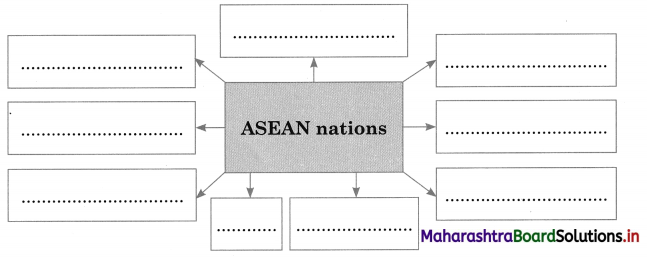
Answer:
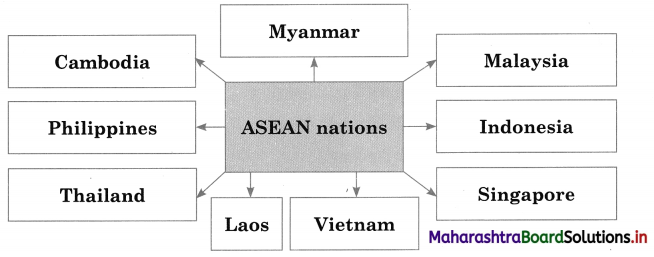
![]()
Question 3.
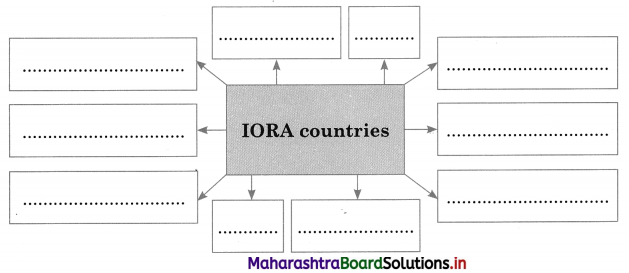
Answer:

Observe the maps in textbook and answer the following questions.
1.
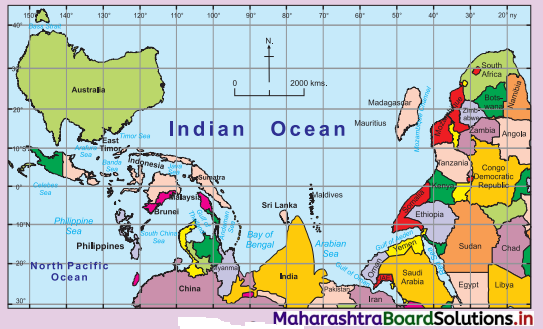
Question 1.
Name the three water bodies bordering India.
Answer:
Bay of Bengal, Indian Ocean, Arabian Sea.
Question 2.
Name three countries bordering India to the North.
Answer:
China, Nepal, Bhutan.
Question 3.
Name three countries bordering Afghanistan.
Answer:
Pakistan, Iran, Uzbekistan, Turkmenistan
Question 4.
Name three countries lying in the Indian Ocean.
Answer:
Sri Lanka, Indonesia, Maldives
![]()
2.
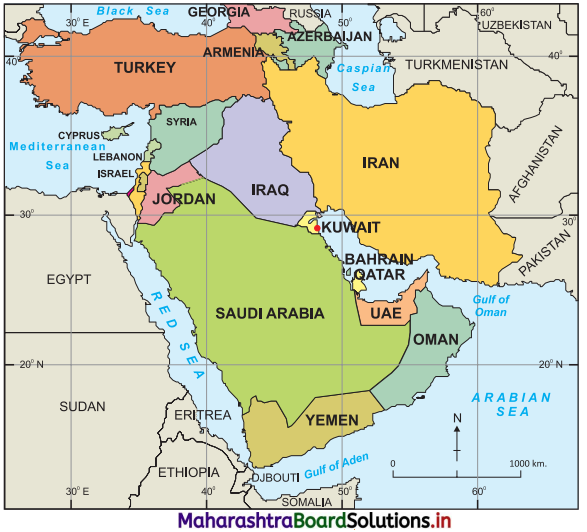
Question 1.
Name three countries around South China Sea.
Answer:
Philippines, Vietnam, China, Taiwan.
Question 2.
Name three African countries bordered by Indian Ocean.
Answer:
Somalia, Mozambique, Tanzania.
Question 3.
Name two West Asian countries bordered by water on the east.
Answer:
Yemen, Oman bordered by waterbody on the east.
State whether the following statements are true or false with reason.
Question 1.
In the past two decades Indo-US relations have improved considerably.
Answer:
This statement is True.
- During the Cold War and even immediately after that, Indo-US relations were strained mainly due to India’s nonaligned policy and US support to Pakistan.
- However, India supported US war on terrorism and later the signing of India-US Civil Nuclear Cooperation Agreement (2008) led to bettering of ties between USA and India. US regards India as a major trade and defence partner.
![]()
Question 2.
International situation has played a significant role in determining India’s Foreign Policy.
Answer:
This statement is True.
- Factors like geography, history, economy, political leadership have impacted India’s foreign policy. During the Cold War, superpower politics impacted India’s policy.
- There were many significant changes in India’s foreign policy when the Cold War ended.
- India’s relations with world powers like USA and with its own neighbours like China and Pakistan have influenced its foreign policy.
Question 3.
Indian foreign policy has undergone a change post 1990s
Answer:
This statement is True.
- During the Cold War era, Indian foreign policy had evolved around three pillars viz. nonalignment in international relations, preservation of autonomy in domestic affairs and solidarity among developing nations.
- After 1991, Indian economy opened under economic liberalisation. India developed relations with different nations based on realistic understanding of national interest. Thus, India emerged as a significant economic and technological power post 1990s.
Explain the correlation between the following.
Question 1.
Political leadership – India’s foreign policy.
Answer:
The principles of India’s foreign policy include respect for the sovereignty and territorial integrity of all nations, belief in peaceful coexistence and peaceful resolution of international disputes. One of the main factors influencing foreign policy is the political leadership of the country. India’s first Prime Minister Jawaharlal Nehru’s speech spelt out the core feature of India’s foreign policy i.e., friendly relations with England, USA and Soviet Union.
He was a co-founder of the Non- Aligned Movement and opted not to be a part of any military alliance. Prime Ministers who have played an important role in India’s foreign policy include Lai Bahadur Shastri (Indo-Pak war 1965 and Tashkent Agreement) Indira Gandhi (Indo-Pak war, 1971 and Shimla Agreement) Rajiv Gandhi (peacekeeping force to Sri Lanka, 1987), Atal Bihari Vajpayee, Dr. Manmohan Singh and Narendra Modi.
![]()
Express your opinion of the following.
Question 1.
India-US relations.
Answer:
During the Cold War, relations between India and US were strained due to several reasons
- India kept out of US led military alliances like CENTO, etc., and co-founded Non-Aligned Movement.
- India’s criticism of US intervention in Vietnam.
- US position on the Kashmir issue and constant support to Pakistan.
Even after end of the Cold War, Indo-US relations did not immediately improve. The US brought pressure on the new State of Russia to stop supply of space technology to India. After India carried out its second nuclear testing in 1998 at Pokhran, the US not only imposed economic sanctions on India but also pressurized other nations like Canada, Japan, etc. to impose sanctions as well. However, towards the end of the last century Indo-US ties have improved due to the following reasons-
1. Anti-terrorism stance – India supported President George W. Bush’s “war on terrorism” similarly, after the 2001, terrorist attack on Indian Parliament by Pakistan supported terrorist groups, US demanded that Pakistan should stop sponsoring cross-border terrorism.
2. Partnership apd Agreements – The US regards India as a major partner in the Indo- Pacific region. India regards the USA as a major source of investment and partner in trade and defence as well as in multilateral fora like India-US-Japan forum. In 2008, the India-US Civil Nuclear Cooperation Agreement was signed by which India became the only country outside NPT that has nuclear capabilities.
Answer the following questions in 80 to 100 words.
Question 1.
Elaborate on India’s “Look East, Act East” policy.
Answer:
After independence, Jawaharlal Nehru attempted to weave unity among countries of Asia. One of the major partners in this effort was Indonesia. During the Cold War period, India’s relations with most of the South-East Asian nations was nominal. In 1991, India under Prime Minister P. V. Narsimha Rao propounded the “Look East” Policy as an effort to cultivate extensive economic and strategic relations with the South-East Asian countries and bolster it’s standing as a regional power. Subsequent Prime Ministers such as Atal Bihari Vajpayee and Dr. Manmohan Singh also pursued this policy.
In 2014, under Prime Minister Narendra Modi a more outcome-based policy of Act East was announced to focus more on relations with ASEAN and other East Asian countries especially Vietnam and Japan. India has particularly good relations with Singapore which is a major investor in India. Relations with Thailand, Malaysia, Indonesia have also improved. India has a Free Trade Agreement with the ASEAN and is a partner in ASEAN Regional Forum (ARF) a regional security group. India has promoted regional cooperation groups like BIMSTEC.
![]()
Question 2.
Describe India-Pakistan relations.
Answer:
1. There have been tensions and military standoffs between India and Pakistan since 1947 for e.g., Conflict of 1947-48, Kargil conflict (1999) as well as two-wars (1965, 1971). The main problem areas between India and Pakistan is over the Kashmir issue. India has accused Pakistan of sponsoring cross border terrorism in Indian territory.
2. China-Pakistan Economic Corridor is a route for Chinese investments in Pakistan. China has extended support to Pakistan on the Kashmir issue while Pakistan recognizes China’s claims to Aksaichin.
3. Disputes over sharing of the Indus river waters and Baglihar Dam issue. Efforts have been made to improve bilateral relations between India and Pakistan such as the Shimla Agreement (1972) signed between Prime Minister Indira Gandhi and President Z. A. Bhutto. In 1999, Prime Ministers of India and Pakistan signed three agreements. Both countries have launched several mutual confidence building measures such as the Delhi-Lahore bus service, hotlines between Prime Ministers of India and Pakistan, etc.
Answer the following question with reference to the given points.
Question 1.
Elaborate on India’s relations with
(a) USA
(b) Russia / Soviet Union
(c) China
Answer:
India has played an active role in international relations even before independence for e.g., as a signatory at the San Francisco Conference that gave shape to the United Nations Charter.
The primary objectives of India’s Foreign Policy are:
- Maintenance of international peace and security.
- Protection of the sovereignty and integrity of the country.
- Maintaining good relations with neighbouring countries and with regional groups such as ASEAN.
- Greater integration with the world economy in order to sustain a high growth rate.
(a) USA – During the Cold War, relations between India and US were strained due to a number of reasons:
- India kept out of US led military alliances like CENTO, etc., and co-founded Non- Aligned Movement.
- India’s criticism of US intervention in Vietnam.
- US position on the Kashmir issue and constant support to Pakistan.
Even after end of the Cold War, Indo-US relations did not immediately improve. The US brought pressure on the new State of Russia to stop supply of space technology to India. After India carried out its second nuclear testing in 1998 at Pokhran, the US not only imposed economic sanctions on India but also pressurized other nations like Canada, Japan, etc. to impose sanctions as well.
(b) Russia / Soviet Union – During the Cold War era, Soviet Union provided aid to India in the form of technology, weapons and low-interest credit to India’s heavy industry projects in the public sector. Indo-Soviet Friendship Treaty (1971) is considered a milestone in their bilateral relations. After the disintegration of the Soviet Union, Russia agreed to provide reactors for India’s Kudankulam nuclear power plant and for joint ventures to produce Sukhoi fighter aircraft and Brahmos missiles. Both India and Russia have major Stakes in Russia oil fields such as Sakhalin-1 highlighting the importance of energy security.
(c) China – In 1949, the Communist revolution took place in China. India was among the first nations to recognize the People’s Republic of China. In 1954, India and China signed the Panchsheel Agreement and India also recognised Chinese Suzerainty on Tibet. The main hindrances in Sino-Indian relations are-
- 1962 Indo-China war and 2017 Dokhlam skirmish.
- Border disputes in AksaiChin and NEFA region.
- China has been critical of India offering political asylum to the Dalai Lama.
- Chinese support to Pakistan.
- India’s apprehensions about China’s Belt and Road Initiative.
On the positive side India-China relationship has improved
- Agreement on maintenance of peace and tranquility along the LOC.
- China has become among the largest trading partners of India.
- India and China are part of BRICS and SCO.
- In the late 1990s, Russia mooted the idea of a Trilateral Summit of Russia, China, India which was a recognition of India’s status as a major regional power.
![]()
Question 2.
Elaborate on India’s relations with
(a) Pakistan
(b) Bangladesh
(c) Sri Lanka
Answer:
India has played an active role in international relations even before independence for e.g., as a signatory at the San Francisco Conference that gave shape to the United Nations Charter. The primary objectives of India’s Foreign Policy are:
- Maintenance of international peace and security.
- Protection of the sovereignty and integrity of the country.
- Maintaining good relations with neighbouring countries and with regional groups such as ASEAN.
- Greater integration with the world economy to sustain a high growth rate.
(a) Pakistan-
1. There have been tensions and military standoffs between India and Pakistan since 1947 for e.g., Conflict of 1947-48, Kargil conflict (1999) as well as two wars (1965, 1971). The main problem areas between India and Pakistan is over the Kashmir issue. India has accused Pakistan of sponsoring cross border terrorism in Indian territory.
2. China-Pakistan Economic Corridor is a route for Chinese investments in Pakistan. China has extended support to Pakistan on the Kashmir issue while Pakistan recognizes China’s claims to Aksai Chin.
3. Disputes over sharing of the Indus river waters and Baglihar Dam issue.
Efforts have been made to improve bilateral relations between India and Pakistan such as the Shimla Agreement (1972) signed between Prime Minister Indira Gandhi and President Z. A. Bhutto. In 1999, Prime Ministers of India and Pakistan signed three agreements. Both countries have launched several mutual confidence building measures such as the Delhi-Lahore bus service, Samjhauta Express, hotlines between Prime Ministers of India and Pakistan, etc.
(b) Bangladesh – India played a major role in securing independence for Bangladesh in 1971. Major issues in Indo-Bangladesh relations were about distribution of waters of Teesta river, land and maritime boundaries, Chakma refugees, etc. Cross border terrorism is a concern for both countries.
(c) Sri Lanka – India is the only neighbour of Sri Lanka, separated by the Palk Strait. They share deep racial and cultural links. For most of Tamils in Sri Lanka (earlier Ceylon) their ancestors were from India. Ties between the two countries have been tested by the Civil War in Sri Lanka and Indian intervention during the war (1983-2009). It was caused by insurgency against the government by the Liberation Tigers of Tamil Eelam (LTTE) which aimed to create an independent Tamil State in the north and east of Sri Lanka.
The LTTE was formed in 1976 under leadership of V. Prabhakaran as Tamils began to feel alienated in Sri Lanka due to Sinhala being made official language and Tamil migrant plantation workers being disenfranchised. Indian Prime Minister Rajiv Gandhi deployed the Indian Peace Keeping Force (IPKF) under Operation Pawan to disarm different militant groups in Sri Lanka. The Indo-Sri Lanka Accord (1987) was signed to provide a political solution to Sri Lanka’s conflict.
Today, India is Sri Lanka’s largest trading partner. Both India and Sri Lanka are members of SAARC and BIMSTEC. Sri Lanka’s leaning towards China e.g., Hamabantota port being built in Sri Lanka by China is a major concern for India.